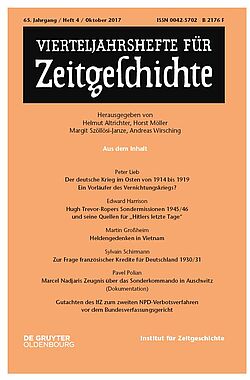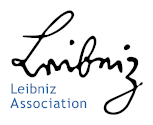- The Institute
- Research
- Dictatorships in the 20th Century
- Democracies and their Historical Self-Perceptions
- Transformations in Most Recent History
- International and Transnational Relations
- Edited Source Collections
- Dissertation Projects
- Completed Projects
- Dokumentation Obersalzberg
- Center for Holocaust Studies
- Berlin Center for Cold War Studies
- Publications
- Vierteljahrshefte
- The Archives
- Library
- Center for Holocaust Studies
- News
- Dates
- Press
- Recent Publications
- News from the Institute
- Topics
- Munich 1972
- Confronting Decline
- Feminist, Pacifist, Provocateur
- Der Mauerbau als Audiowalk
- Digital Contemporary History
- Transportation in Germany
- Envisaged Futures at the End of the Cold War
- From the Reichsbank to the Bundesbank
- German Federal Chancellery
- History of Sustainabilities: Discourses and Practices since the 1970s
- Changing Work
- Democratic Culture and the Nazi Past
- The History of the Treuhandanstalt
- Foreign Policy Documentation (AAPD)
- Dokumentation Obersalzberg
- Hitler, Mein Kampf. A Critical Edition
- "Man hört, man spricht"
- IfZ
- Vierteljahrshefte
- VfZ Archive
- Issue Index
- Issue October 2017
- Printversion
Issue 4/2017
Content Overview: English Titles and Abstracts:
- Peter Lieb: The German Eastern Front, 1914-1919. A Precursor of the War of Extermination?
- Edward Harrison: Searching for Traces. Hugh Trevor-Roper’s Special Missions in 1945-46 and his Evidence for “The Last Days of Hitler”.
- Martin Großheim: War and Death. Remembering Heroes in Vietnam.
- Sylvain Schirmann: The Question of French Loans to Germany in 1930/31. The French Approach.
- Pavel Polian: Reading the Unread. The Deciphering of the Account of Marcel Nadjari, Member of the Jewish Sonderkommando in Auschwitz-Birkenau.
Abstracts
Peter Lieb, The German Eastern Front, 1914-1919. A Precursor of the War of Extermination?
In recent years, mostly in Anglophone circles, there has been a discussion regarding a “German Way of War”. According to this thesis, the German Empire embarked on a military “Sonderweg” [special path] in contrast to other states. This was supposedly particularly evident in a more radical form of warfare exhibited during colonial wars and the First World War. This view postulates a continuity of German military culture between the First and the Second World War. The present article tests this thesis by means of an examination of the Eastern Front during the First World War and concludes that the supposition of a specifically German military culture during the German Empire and a continuity between the form of warfare practised on the Eastern Front of the First World War and “Operation Barbarossa” often bears the markings of a backward-looking projection. In comparison to the Austro-Hungarian as well as the Russian Army, the German military was the most restrained until late 1917. Ultimately the success of Bolshevism since late 1917 led to a radical mental change; the state of command now exasperated, as the counterinsurgency in Ukraine in 1918 demonstrated. Simultaneously the German Army also largely tried to go easy on the civilian population. A further surge of radicalisation was revealed in the conflicts in the Baltic States in 1919. These may have possessed a formative character for the later Nazi movement, but not for the military, who saw the “Baltic fighters” as “undisciplined rabble”.
Edward Harrison, Searching for Traces. Hugh Trevor-Roper’s Special Missions in 1945-46 and his Evidence for “The Last Days of Hitler”
Hugh Trevor-Roper’s investigation in autumn 1945 and his subsequent book have been reappraised by Geoffrey Parker and Sarah Douglas in The Journal of Military History. Parker questions whether a single person could have interrogated numerous witnesses single-handed and sifted their evidence in less than six weeks and suggests that Trevor-Roper spent most of his time reading the transcripts
of interrogations carried out by others. Douglas writes that a collective effort of countless interrogators from all over Europe became “The Last Days of Hitler”, a book the text of which she asserts remains the same through every edition. In fact extensive primary sources show that during his autumn enquiry Trevor-Roper personally questioned at least eighteen witnesses or persons with leads to witnesses, and in eleven of these cases a significant interrogation took place. Trevor-Roper was an exceptionally effective interrogator who elicited detail and meaning which had escaped previous questioners. His eagerness to question witnesses himself was not least due to recurrent problems with interrogations carried out by others. Indeed the majority of evidence in his book did not come from interrogations, but from pre-war books, wartime intelligence documents, eavesdropping material, diaries, memoirs, post-war publications, and documents originating from Hitler or the Doenitz government. Once published, the text of “The Last Days of Hitler” was changed significantly for later editions.
Martin Großheim, War and Death. Remembering Heroes in Vietnam
To this day, the Vietnamese State practises a form of remembering the dead, which is designed to justify the high human losses in the wars against France and the USA and to stylise the dead as selfless martyrs in the struggle for independence and the implementation of Socialism. At the centre are the Communist cadres and soldiers, who since 1925 gloriously sacrificed their lives in their service for the revolution and against colonialism and feudalism and who thus deserve the status of “revolutionary martyrs” (liệt sỹ). To date, this restrictive and hierarchical form of remembering the dead, which is expressed in approximately 3 000 Heroes’ Cemeteries throughout the country as well as other memorial sites, serves as a core component of the Vietnamese state remembrance project to legitimise Communist one-party rule. Since the beginning of reform policies (đổi mới) in 1986, however, private forms of remembering the dead outside restrictive state hero worship can increasingly be observed among civil society representatives. The article presents two examples: The commemoration of the fallen soldiers of the Republic of Vietnam, which collapsed in 1975, as well as the military victims of the military conflicts with the People’s Republic of China, who so far do not play a central role in state-driven remembrance.
Sylvain Schirmann, The Question of French Loans to Germany in 1930/31. The French Approach
The economic and political crisis in Germany as well as the revisionism of Brüning alarmed the French authorities from the onset of negotiations regarding the Young Plan. Against this background, Paris then attempted to utilise economic cooperation and financial aid to control the Reich. Even if the French financial propositions of 1930 can be considered as superficial, those of 1931 conversely elong to a different category. France viewed them as part of a French plan for Europe linked to a form of international aid together with the other Western powers. Conceived as a political instrument, this aid was not capable of regulating the frail financial situation in Germany, while Brüning’s policies, for their part, did not prompt France to modify its approach.
Pavel Polian, Reading the Unread. The Deciphering of the Account of Marcel Nadjari, Member of the Jewish Sonderkommando in Auschwitz-Birkenau
This documentation is dedicated to the history of the finding and deciphering of the handwritten account of Marcel Nadjari (1917–1971), a Greek Jew who was a member of the Sonderkommando in Auschwitz-Birkenau, which had to work in the gas chambers and crematoria. It covers one of a total of nine analogous accounts which were composed by five members of the Sonderkommando as a secret message from the centre of extermination and hidden there for posterity. For 35 years, Nadjari’s manuscript remained buried in a thermos flask in the ground and was only discovered in 1980. Its condition was so bad, that only approximately ten percent of the text were legible. The Russian computer specialist Aleksandr Nikityaev however has been able to make almost 90 percent of the text legible through the use of multispectral images, permitting a whole new form of access to the text, which is published here in this form for the first time.
04/09/2024
„Die Lebensbeichte des Bandera-Mörders“
Der "Münchner Merkur" zu Grzegorz Rossoliński-Liebes Dokumentation im Aprilheft der VfZ
mehr
04/04/2024
„Die Beichte des Mörders von Stepan Bandera“
Die „Süddeutsche Zeitung“ zu Grzegorz Rossoliński-Liebes Dokumentation im Aprilheft der VfZ
mehr
04/02/2024
Druckfrisch: VfZ 2/2024
Das Aprilheft der Vierteljahrshefte für Zeitgeschichte ist erschienen
mehr








